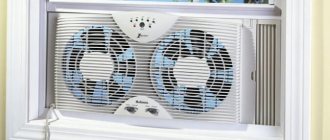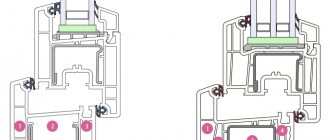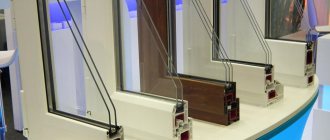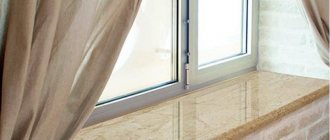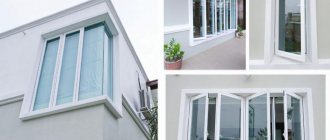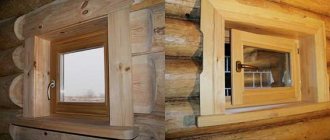A fan for supplying or extracting air can be installed not only in an air duct or in a hole in the wall. There are models for installation in a window. They are used both in everyday life (in apartments) and in industrial facilities.
In the Soviet years, such devices could often be seen in windows. Nowadays they are not installed so often, but the choice has become much more extensive.
We won’t talk about the device and operating principle: these are simple centrifugal fans powered by electricity. So let's start right away with the varieties.
Application of window fans
One of the most important advantages of a window fan is its compactness. Having small dimensions, it is easy to install in a vent or window. At the same time, it will be invisible: for a better aesthetic condition of the window, various blinds are used, which open when the fan is running and close when it is turned off, thereby hiding the ventilation equipment from view.
The above advantages also include low noise from the fan operation, as well as the fact that when the fan is built into the window, an air duct system is not needed.
These qualities make it possible to use window fans in offices, apartments and houses, in industrial premises, and in catering premises.
How to install and connect?
There is nothing complicated in installing window fans; you just need to follow very important rules and take into account certain nuances. The following nuances must be taken into account:
- you cannot fix the device on ordinary glass, because, despite the vibration protection, the device still vibrates quite strongly and can simply damage the glass;
- when installing a product on a plastic window, you must pre-order the installation of a fan during the production of the window itself - in this case, the manufacturer will pre-make a window with a connector specifically for the selected fan model, but independent installation on a plastic window often ends in its damage and loss of tightness.
Standatd household exhaust fan
| ||||
| ||||
| Household exhaust fan Standard 4 | Household exhaust fan Standard 5 | |||
| speed 1 | speed 2 | speed 1 | speed 2 | |
| Flange diameter (mm) | 100 | 125 | ||
| Productivity (m³/hour) | 100 | 60 | 185 | 125 |
| Max. pressure (Pa) | 38 | 18 | 48 | 26 |
| Supply voltage (V) | 220-240 | |||
| Power consumption (W) | 16 | 7 | 20 | 7 |
| Current consumption (A) | 0,07 | 0,03 | 0,09 | 0,03 |
| Noise level (dB) | 35 | 23 | 36 | 26 |
| Max. operating temperature (°C) | 40 | 40 | 40 | 40 |
| Weight (kg) | 0,50 | 0,55 |
* first speed, ** second speed
Features of Window Fan
Household window fans have a number of characteristics that clearly distinguish them from other ventilation devices:
- minimal energy consumption;
- low noise level;
- blinds are equipped, which helps maintain their tightness;
- the built-in outer cover protects against precipitation;
- small sizes;
- affordable prices for devices;
- easy installation;
- Possibility of speed control using the remote control.
There are many factors to consider when choosing an exhaust window fan
When purchasing a fan, you must consider the following characteristics:
- noise level of the model;
- the power of the device must correspond to the living space;
- equipping the device with devices that eliminate the effect of backdraft insures the device against insects and
- dusty air.
A window exhaust fan works like an extractor hood; the exhaust characteristics of this type are optimal. The air flow or stream of air is directed outward, from the room to the street. Main goals:
- drawing out excess heat;
- excess moisture;
- various gases;
- dust.
Such models consume up to 10–20 W, and perform up to 4 thousand rpm. Household fans, made in Italy, are adapted to work in rooms where there is a significant temperature difference between the house and the street, such a room is the vestibule. The temperature difference in the vestibule of a living space reaches its maximum during the heated period.
In the vestibule, it is better to install an exhaust window fan made with special blinds; such a device retains heat. The fan shutters close when turned off from the network; this device does not have reverse draft, due to which heat is lost. And fans with a cover are also used, their operating principle is the same as that of a fan with blinds.
Window fans are made of plastic
Window exhaust fans are made of plastic; this material is heat-resistant, impact-resistant, and immune to ultraviolet radiation. Plastic fan elements undergo special laboratory testing; the plastic must withstand temperature changes from +50°C to -50°C.
Device characteristics and application
A window fan increases circulation in a room with metal-plastic windows.
A window fan is an indispensable device in cases where it is not possible to make another air conditioning system. Also, due to the widespread use of plastic windows, the installation of such a device is required. Modern double-glazed windows prevent natural air circulation, which disrupts the balance and healthy microclimate in the room. The device does not make noise during operation, which is its important advantage, and also consumes little electricity.
The positive aspects of installing a window fan include:
- Constant air exchange in the room. The room will constantly be filled with oxygen.
- Replacement of bulky ventilation systems.
- Compactness of the device.
- Effective removal of unpleasant odors.
- Economical. Electricity consumption for fan operation is minimal.
- Possibility of adjusting the operation of the device. For this, a special regulator is used, on which you can set the operating mode.
- High efficiency.
- Reliability.
- A wide range of models for any area and power.
- Price.
- Independence from weather conditions.
- Protection from dust and precipitation.
- Ease of installation.
During installation, it is necessary to follow the technology so as not to destroy the glass.
The negative aspects include:
- The need to replace the glass structure. When installed on metal-plastic windows, the seal may be damaged.
- There is a little noise during operation.
- The presence of heat losses, which can be reduced by using a device with curtains. When the blinds are lowered, the fan switches off automatically.
- If the installation technology is not followed, there is a risk of damage to the glass unit.
A home window fan has the following technical characteristics:
- Power. The indicator for a household device is 15-20 W. Thanks to its low power, it provides virtually silent operation compared to hoods and ventilation systems.
- The average speed of the blades is 3000 rpm.
- The case material is plastic, which is resistant to atmospheric influences and temperature fluctuations.
- Operating temperatures range from -50°C to +50°C.
- Service life 15 years or more.
Often window fans are installed in basements (cellar, storage). Condensation accumulates in them, which can destroy the structure, so a ventilation system is installed to remove excess liquid. Stagnant air with its characteristic odor will also be successfully removed.
How to ensure ventilation in an apartment with sealed plastic windows
Owners often ask the question: how to make ventilation in an apartment with plastic windows? The right choice is to install the supply valve on the window profile. The supply valve is a special device that is mounted horizontally on the upper sash of the window profile; the main task of the valve is to restore natural ventilation in the room. The supply valve facilitates the flow of fresh air from the atmosphere. There are several important advantages of the device:
The supply valve is necessary for the flow of fresh air from the atmosphere
- the valve does not close the window opening;
- the valve facilitates the supply of fresh air;
- ventilation occurs without loss of warm air;
- the valve does not affect the level of sound insulation of the profile;
- ventilation without harm to health (no draft);
- autonomy from the window profile;
- installation of valves does not violate the integrity of the window frame.
Inlet valves come in different types: made of wood, plastic and metal. The valves can be controlled automatically or manually. Automatic adjustment is effective and convenient, since the need to close and open the ventilation duct is determined independently, without human intervention. The valve is adjusted according to changes in pressure and changes in air humidity in the room.
It is better to install the valve directly with plastic windows, in plastic windows, on plastic windows; with this type of installation, you do not need to use the wall near the window, changing its appearance. When choosing a valve, it is necessary to study its characteristics regarding sound insulation; the metal-plastic profile should have similar characteristics. It should be remembered that the valve needs to be looked after - periodically cleaning the outer visor grille from dirt, and wiping the valve body with a damp sponge.
A variety of ventilation devices helps you choose the best option for your home
It is important to remember that any ventilation device has both positive and negative characteristics, so its choice should be made carefully and thoughtfully
The axial reversible fan is used in air conditioning and ventilation systems. Equipment of this type has found wide application in various spheres of human activity. This popularity is due to its high performance characteristics and a large number of advantages.
Main factors for installing window ventilation
As you know, ventilation helps to ventilate a room, releasing recycled air outside and simultaneously filling the home with oxygen. This process is designed to ensure a healthy lifestyle for any person; it has important sanitary and hygienic significance in the living environment.
In addition to the impact on health, proper air exchange helps save electrical and thermal energy in the house. In many old houses, the window frames have many gaps and lack the necessary sealing. On the one hand, this helps to ensure natural air exchange, allowing the entire house to be ventilated. Air passes through all rooms where windows are installed. On the other hand, this causes heat to pass through during the cold season, which ultimately leads to unnecessary financial costs aimed at providing the required heating of the living space.
Modern models of windows made of PVC, aluminum and wood with high-quality thermal insulation and sealing solve this problem, but at the same time create another. Natural ventilation is completely lost, and recycled air is not removed from the room. Without supply air, the functioning of the exhaust system is disrupted. A family of 3-4 people produces up to 10-15 liters of wet deposits per day (sweat, breathing, cooking, cleaning the room, etc.). The normal amount of fresh air is reduced. At the same time, the level of carbon dioxide increases, as well as other harmful substances released from the environment (this can include household appliances).
Thus, the house becomes stuffy, condensation forms on the glass, walls and arched openings, which creates a favorable environment for the appearance of fungus, mold and harmful bacteria. Today, all homes are filled with various types of household appliances. Few people know that it is one of the sources of allergenic substances. If you stay in an unventilated room with household appliances for a long time, your head starts to hurt (attacks of suffocation and allergies are less common). To prevent such consequences, it is necessary to ensure proper air exchange inside the room.
Of course, the simplest way to ventilate a room is by opening a window. But in this case, dust, poplar fluff, strong winds, and in winter also cold air penetrate into it. For this reason, the best solution would be to install forced-air window ventilation.
Return to contents
Advantages of axial reversible fans
- Relatively small dimensions;
- Great design;
- Overheat protection and easy operation;
- Long service life;
- Options for overhead and hidden execution;
The peculiarity of devices of this type is the ability to provide mixing of air flows. This effect is achieved by changing the rotation of the impeller with a symmetrical blade profile. Air performance depends on the mode in which the blade impeller moves.
A reversible fan is installed in a window or wall opening. It is also possible to install the device in a ventilation duct. It can be used in the kitchen, bathroom, workshop, garage and other domestic premises. This equipment quickly purifies the air, eliminates unpleasant odors, and removes harmful substances.
The reversible window fan is affordable. At the same time, its quality does not raise any doubts, because products of this type are manufactured in accordance with established standards and requirements. It is worth noting that all elements of the equipment casing are made of ABS plastic. Thus, the window fan becomes as durable and wear-resistant as possible.
How to choose
The best option due to the versatility of operation is a supply and exhaust system. However, such a fan has a higher cost. If it is not possible to purchase it, then you can buy an analog exhaust for the bathroom and kitchen or an air supply system for the living room, study, bedroom, office. For rooms from which it is necessary to remove contaminated air in large volumes, a suitable option is to install a three-phase window fan, characterized by increased performance and power.
When purchasing, it is important to consider product characteristics such as power, performance and size.
Another parameter that is worth paying attention to is how many times the air completely changes within an hour. If we are talking about using a fan in residential areas, then 2-6 times is enough.
For bathrooms, this figure increases to 6-10 times per hour. The maximum indicator is for devices mounted in the kitchen. Here the air must be completely changed at least 10-15 times within an hour. The more actively the room is used and the more people there are in it, the more times the air must be changed.
The calculation of the required power of the structure is carried out taking into account the dimensions of the room and its purpose. For example, for air exchange in a kitchen with an area of 30 m2, you should purchase a fan with a power of at least 300 m3 per hour. This indicator can be obtained by multiplying the area of the room by the required number of air changes.
The size of the device must correspond to the dimensions and strength of the window. The device should not obstruct it or prevent the penetration of sunlight. For home and office, you should choose devices whose noise figure during operation does not exceed 30 dB.
It is desirable that reversing devices be equipped with an anti-vibration gasket that prevents the spread of vibrations to the glass unit. For residents of central Russia, especially for those who live in harsh climatic conditions, you should choose devices with a sealing elastic band - blinds or a lid that will prevent heat loss in cold weather.
When purchasing, you should give preference to products from well-known brands, making sure that the fans offered by the seller are original. Devices from such brands as Domovent, Klimat, Vents, Fluger, Eleyus, Soler&Palau have proven themselves well.
Installation instructions (+video on installation in a window)
Let’s say right away : installing a fan in a window glass yourself is almost impossible. It's too complex and highly specialized a task.
The glass itself can be damaged quite easily in the process, and you will have to buy a new double-glazed window. Therefore, for most people, it is better to entrust the installation to a specialist. The approximate cost of installation is from several thousand rubles.
If we are talking about metal-plastic double-glazed windows, you will have to completely replace them, buying glass with an already cut hole.
If we are talking about old windows or new, but single-glazed ones, the installation will look like this:
- A hole is cut in the glass to the size of the fan housing.
- The housing is inserted into the hole and secured.
- During the installation process, all joints and leaks are coated with sealant, or rubber seals are used.
Installation is described so briefly and generally because installation conditions can vary greatly. There is no point in listing them; the easiest way is to call a specialist and assess the situation on the spot.
How a dust fan works: overview, types and scope of application
Related Posts
Official VENTS website
- Product catalog Menu
- Household fans
- Menu
- Energy-saving axial fans with low noise levels
- Axial duct fans
- Axial wall and ceiling fans
- Axial decorative fans
- Fans with light
- Axial window fans
- Centrifugal fans
- Accessories for domestic fans
Smart fans
- Menu
Fans for round ducts
- Menu
Room reversible units TwinFresh
- Menu
Supply and exhaust units
- Menu
Air heating (cooling) units
- Menu
Roof smoke extraction fans
- Menu
Hydraulic siphon
- Menu
Control units for domestic fans
- Menu
PVC channel system "PLASTIVENT"
- Menu
Lattices
- Menu
Ventilation kits
- Menu
- Menu
- Menu
- Menu
- Menu
- Menu
Kinds
It is customary to distinguish between axial and centrifugal fans for windows.
- The first ones are most widespread due to their efficiency and ergonomics. Air movement in such devices is carried out along the entire axis of the electric motor. The blades form a circle.
- Centrifugal fans are more powerful, but require a massive housing that is installed indoors. The blades are arranged in a spiral, due to which they capture a larger volume of air.
- Industrial professional kitchens are equipped with cross-flow fans, also called “squirrel cages”. They are an elongated cylindrical body, the walls of which are blades bent inward. The latter capture air, and the built-in rotor pushes it into the room.
Depending on the design features and its functionality, there are several types of window fans.
Exhaust
Their purpose is to remove polluted air and various odors. This allows the use of similar options in toilets, kitchens, chemical laboratories, and workshops. The flow of fresh air is provided through open windows or comes from adjacent ventilated rooms.
Inlet
Such structures are located in residential and work areas where there is no need to remove polluted air. Their function is to provide fresh air flow. At the same time, due to the increased pressure created by the supply fan, the speed of air exhaust through the ventilation ducts increases.
This type of fan is also used to cool the room. It can replace an air conditioner, unless we are talking about a situation where the temperature outside the window is too high. Then the fan will blow hot air, which is impractical.
Supply and exhaust
These are multifunctional systems that provide simultaneous exhaust of polluted air and supply of fresh air. Only a reversible fan equipped with an electric motor of suitable power can cope with such a task. The function of influxing fresh air or extracting polluted air is associated with one direction or another of movement of the blades. The operating mode of the device can be determined by special indicators on its body.
Depending on the installation location, window fans differ and their type is vent fans. The latter are more compact in size. They are usually used in plastic double-glazed windows.
Separately, it is worth highlighting slot window fans mounted in the window profile.
Thus, fans can have additional accessories. Among the most common:
- automatic or gravity blinds or covers (prevent heat loss in the room);
- check valve mounted at the outlet of the fan (designed for exhaust structures);
- a valve that allows you to regulate the amount of incoming air (for supply and exhaust fans with a diaphragm);
- protective grilles (prevent debris and dust from entering the device);
- automatic fan control system (includes a control unit or remote control);
- decorative overlays.
Supply window ventilation system
Tools for installing ventilation: knife, tape measure, perforator, spatula.
The main task of such ventilation is to supply a continuous flow of clean air into the room. The formation of clean air is due to the presence of a special filter in the supply ventilation, in addition to which there is a special mesh against insects. Such an air exchange system in no way violates the tightness and sound insulation of windows, that is, modern technological solutions will not lose their main advantages.
The main advantages of supply ventilation:
- Absolute safety for the child.
- The mechanism does not require power supply.
- Convenient operation (manual control).
- There are sound insulation properties.
- The system is equipped with a mosquito net.
- There is an integrated system of protection against penetration from the outside, which allows for air exchange even during the absence of the owner.
- The functioning of the mechanism does not depend on atmospheric and natural conditions.
- There is a control system that prevents drafts.
- The device has a compact size, it is almost invisible to the naked eye.
- The clean air filter is capable of purifying the incoming air from harmful smoke.
- Installation is carried out in any types of windows.
- The device does not require window dismantling or reinstallation.
- Low cost.
Current standards indicate that air exchange should occur at least once per hour. The supply window ventilation system is able to supply the room with clean air even at this level. Modern window models cannot do without such a system.
Return to contents
The principle of operation of supply ventilation
The supply window ventilation system operates on the basis of two parts: an external panel (installed from the outside) and an internal panel (installed from the inside). Both parts are united by a small opening through which fresh air enters. The outer panel is equipped with an automated valve that floats in a stream of clean air. When the difference in pressure increases, the valve rises and closes the opening. Accordingly, as the difference decreases, the valve lowers. According to this scheme, the system supplies the living space with fresh air, regardless of natural phenomena.
The outer panel provides protection from rain entering the opening. It has a built-in mosquito net. The interior is equipped with a sloped panel designed to control the air flow, which is carried out using a special cord.
During the installation of an air exchange system, certain rules must be followed. For example, supply air should be supplied in smaller quantities than exhaust air.
Usually, when choosing a mechanism, a qualified specialist takes into account all the nuances of the living space, but you can estimate them yourself.
Installation must be carried out according to a certain scheme: 1 or 2 devices are placed at points that are located in the most distant places from the exhaust duct of the kitchen and bathroom. This will ensure optimal levels of ventilation in all areas of the house. When installing, you should pay attention to the fact that one device is intended for 2-3 hoods. Otherwise, air exchange will not occur correctly.
Return to contents
Adviсe
When installing the device with your own hands, you must use special components at the junction points of the structure. The purpose of the components is to completely seal and securely fix the junction points. During installation, it is also advisable to use sound-insulating gaskets, which significantly increase the comfort of using the fan.
Installation in most cases begins with replacing the standard double-glazed window with a stronger one. Next, a hole is made in the glass that exactly matches the size of the fan. Perforations are also made for mounting the device. After this, the glass is framed and mounted in the window opening. Then you can proceed to install the fan according to the instructions.
If the unit is intended for PVC double-glazed windows, then the device must be installed directly at the stage of its manufacture. In such cases, the fan is usually located in the window.
You can watch a video review of one of the best window fan models - Elicent BUILT-IN (Italy) in the video below.
Pros and cons of using
When choosing a supply and exhaust window device, you need to understand all the advantages it has:
- small sizes. Possibility of installation even in a small opening;
- affordable price category;
- works both at positive and negative temperatures (unlike, for example, a split system, which cannot be used in cold weather);
- easy installation. If a number of conditions are met, even a non-specialist can handle the installation. It also does not require assembling a network of air ducts for its operation. Even the presence of ventilation shafts in the building is not important;
- the ability to control the speed and direction of rotation;
- low noise level;
- energy saving;
- high performance;
- ease of control. There are models with a remote control.
Since all reversible window models are equipped with an anti-vibration gasket, vibration does not spread to the window.
The disadvantages of this device include:
- When the window mechanism operates in winter, warm air is ejected from the room and cold air is forced in. Thus, heat loss inside the building increases, and additional resources may be required to heat the room;
- Although it is possible to select a device with a low noise level, it cannot be completely eliminated.
Selection rules
If you need to choose a household fan, you need to pay attention to:
- Installation method. The most important point, if you already have windows, is to first find out whether it is possible to install a fan in them at all, and whether anyone will undertake this.
- Will your glass hold up? If the fan is installed in standing plastic windows, this also needs to be clarified. You need to ask either the seller in the store (this is not a very good option, since you need to look at it live), or, ideally, call a specialist at home.
- Ability to control rotation speed. It is not necessary, but it is advisable for the fan to have several speeds. For example, you can keep it on at minimum speed all the time, and turn it on at maximum speed when smoking/cooking.
- Reverse. Of course, most often they are installed in kitchens, and only exhaust fans, but a reversible fan will not cost much more than a “one-way” fan. Therefore, it is better to take one just in case.
- Control method. The cheapest models with 1 speed can only be turned on and off, for which they usually have simple cord switches (pull the cord - the device turns on, pull again - it turns off). More expensive models have a remote control.
- The presence of blinds (check valve). A very useful option: if there are blinds, in cold weather, when the fan is not working, they will not allow cold air to flow inside. Of course, instead of blinds there can be a manual shutter, but you will have to open and close it yourself.
- The presence of a damper (lid). A mandatory item is to block the hole when the device is turned off.
- Performance. The only “quality” characteristic. Selected based on the volume of the room: the fan must remove 1 volume of air per hour. That is, if your kitchen has an area of 9 square meters and a ceiling height of 2.5 meters, its volume is 22.5 m³.
Model with lid
A small clarification about performance. According to SNiP 2.08.01-89, at least:
- 60 m³/h if there is a 2-burner stove;
- 75 m³/h if there is a 3-burner stove;
- 90 m³/h if there is a 4-burner stove.
Therefore, if you do not have a “regular” kitchen hood, and a window fan will replace it, focus on these indicators.
This advice is rather theoretical - in practice, even cheap models with a price of 1000 rubles will have a productivity of 100 m³/h+.
Advantages and disadvantages of use
The advantages include the following factors:
- no need to make a hole in the wall (as would be required to install an air supply unit/valve);
- low noise level (a kitchen hood can make noise about 50-60 dB or louder, a fan - on average about 30 dB);
- low power consumption (on average the hood power is from 0.3 kW, the power of a simple window fan is about 15-25 W);
- there is no need to lay an air duct (as for a kitchen hood).
Now about the cons:
- The fan will reduce visibility from the window and natural light.
- The passing air flow (if it comes from the outside inside) cannot be heated, filtered or cooled (unlike wall units and recuperators).
- In winter, cold air can enter the room through a non-working fan (even if the model with a cover is not a guarantee that this will help much).
- If there is no hole/block for the fan in the window, installing it will be very difficult (and essentially impractical).
- Not every glass can withstand a fan. If you place it in plain glass, it may crack (due to vibration of the motor, especially if it operates at high speed).
Is it worth installing such a fan?
Worth it if:
- Are you planning to replace the windows in your kitchen?
- There is no way to install a “regular” hood in the kitchen (for example, the ventilation shaft is damaged/clogged, or it doesn’t exist at all). In this case, a fan placed in the window will become its replacement. Although you can do it easier and install a fan in the wall.
Similar Soviet models were installed in old windows
In other cases, it’s easier to choose another option. This solution is specific, and simply choosing it is not very convenient.
Approximate cost and short list of models
For your reference, here are the prices for several different models:
- Era, size (diameter) 178 mm, with lid on the outside. Productivity - up to 280 m³/h, power - 16 W, for glass with a thickness of 3-6 mm. The cost is about 1000 rubles.
- Aeromat 100, type A (rectangular block, mounted in the sash). Productivity - up to 75 m³/h, power - 17 W. The approximate cost is from 16,500 rubles.
- Soler&Palau, simple model. Diameter - 174 mm, with blinds (check valve) and protective mesh. Power - 25 W, productivity - up to 400 m³/h. Costs about 2700 rubles.
- Soler&Palau HV, reversible model, with remote control. Diameter - 260 mm, power - 34 W, productivity - 600 m³/h. Costs about 16,000 rubles.
- Domovent. OK 150 Diameter - 150 mm, productivity - about 280 m³/h, power - 16 W. The cost is about 1000 rubles.
- Vents 125 MAO1T, with shutdown timer and blinds. Diameter - 125 mm. Can be mounted in glass with a thickness of 4 to 17 mm. Productivity - 185 m³/h, power - 22 W. Costs about 2500 rubles.
- Ventilor, with blinds. Diameter - 200 mm, productivity - up to 450 m³/h, power - 50 W. Costs about 7,000 rubles.
To summarize : a simple model with a mechanical switch and blinds will cost about 1,500 rubles.
Review of the Domovent OK model (video)
Types of window fans
There are three main classifications of window fans:
- Depending on the direction of the air flow. The main view is axial. It is divided into three subtypes with different characteristics: supply, exhaust, supply and exhaust.
- Depending on the location of installation in the window - window and vent.
- Depending on their purpose, fans can be domestic or industrial.
The difference between axial window devices is their simplicity of design and good power. The device consists of a propeller, a motor that rotates the blades, and a housing in which they are fixed.
By design
The axial type of design allows you to create a powerful air flow thanks to the blades.
All models of axial window systems differ from each other; they may have different parameters, sizes, screw diameters and blade lengths. The number of blades and motor power may also vary.
The supply fan draws air flow from the street into the room. This type of ventilation is recommended to be installed where there is no need to purify the air and remove unpleasant odors.
It is designed to fill the room with fresh air. Most often, air supply units are used in office and industrial premises, as well as in residential and guest rooms.
An exhaust fan removes air from the room to the outside. This type is usually used in kitchens, where a wide variety of smells are most often present.
If you have such a device, you don’t have to buy a standard kitchen hood, which usually makes a lot of noise during operation.
You can also use both devices, alternating depending on the required power or turning them on simultaneously to quickly remove odors.
The exhaust blades rotate at speeds of up to 4000 rpm, consuming a small amount of electricity. The device removes polluted and exhaust air, eliminates excess humidity, ventilates and cools the room.
If you purchase this type of axial exhaust device with additional protection in the form of blinds, then you don’t have to worry about the occurrence of reverse draft.
The supply and exhaust device (reversible fan) can operate in two modes: supply and exhaust.
Usually they change automatically after a certain period of time, but you can purchase a device with the ability to manually regulate and select modes.
This type can even be called a ventilation system, since it operates in both directions. With its help, you can completely ventilate the room, removing stagnant and exhaust air outside and letting clean and fresh air in.
Reversible window fans have filters on both sides that purify the air. In addition, the device heats the outside air before supplying it to the room using a heater. All this is possible thanks to the special design of the device.
By location in the window
The location of the device in the double-glazed window may also differ:
- In glass. You can purchase a double-glazed window with a ready-made opening for the fan, and then buy the device itself. Sometimes a window can be purchased with a ventilation device installed in it. This option is preferable, since no effort is required to select the right size for the finished opening.
- In a separate block like a window.
- Framed. This option is one of the best, since the device does not cut into the glass, but into the frame. The downside is the high cost, low prevalence of the model and complexity of installation.
By purpose
Fans can also be divided into domestic and industrial. Each of these types is suitable for certain conditions.
The advantage of household fans is their small size, relative cheapness and easier installation. They require little energy to operate and produce little noise during the process.
The system does not remove heat from the room during ventilation and does not allow the penetration of dirt and dust from the street. The household appliance is used to maintain a comfortable indoor microclimate.
Industrial ones are used for ventilating production, warehouse and factory premises, since they require high-power fans to supply fresh air and remove harmful substances.
Most often, installation is provided for when planning a building or during the construction phase. The disadvantages of this type include high levels of noise and vibration during operation.
Thus, each type differs in size, structure, appearance, functionality and power. And each has its own advantages, disadvantages and features.
Vortice Vario 230/9″ AR – full functionality
High quality product from an Italian manufacturer. The window fan can operate in supply and exhaust mode. Equipped with automatic blinds. High-quality materials and ball bearing supports significantly increased the overall service life of the assembled product.
Increased rotation speed and productivity. The outer grille is made in a weather-resistant design. The body and blades are made of impact-resistant polymer. Power supply: from a stationary power supply of 220 volts.
Pros:
- Supply and exhaust ventilation, automatic blinds.
- Reliability, durability, service life.
- Easy installation and operation.
Minuses:
- High noise at full load.
- The price is high.
Types of window fan
There are many types of window fans. The most common are: window exhaust, window reversible supply.
A reversible window fan simultaneously performs two tasks:
- elimination of polluted air;
- influx of clean air stream.
Ventilation in windows using a reversible fan is reliable and efficient. Such a fan changes the direction of the moving air stream, works as an exhaust hood, in the mode of removing exhaust air, and in the mode of influxing clean air from the atmosphere. The operating mode is set automatically or using the control panel. Advantages of a reversible window fan:
- simple installation: the equipment can be installed in the window opening and secured with bolts;
- installation of the fan does not require an air duct system;
- fans are small-sized;
- have a convenient operation adjustment mode.
When installing window fans, the question often arises, which fan to choose for a certain room? The fan is selected according to the type of room in which it is planned to be installed. For bathrooms, it is suitable to install exhaust or reversible fans, for kitchens - only exhaust fans, for living rooms - to install supply units. Practice has shown that the most functional and most reliable models are supplied to the market by Italy.
Power supply
Some models of this type are equipped with transformers that reduce the mains voltage to 12V and ensure complete safety for users. Each modern reversible window fan is equipped with a position switch, which allows you to manually switch speeds, operating modes (supply and exhaust), as well as turn the device on or off. If desired, you can order the device with a remote control.
The innovative reversible DC motor has a speed of up to 3000 rpm and low energy consumption. The DS engine is designed for 12V voltage, operates in two-speed mode and has a reduced noise level thanks to special design solutions. A particularly attractive feature is its reliability: the engine is protected against overheating, is designed for a continuous cycle and does not require maintenance.
